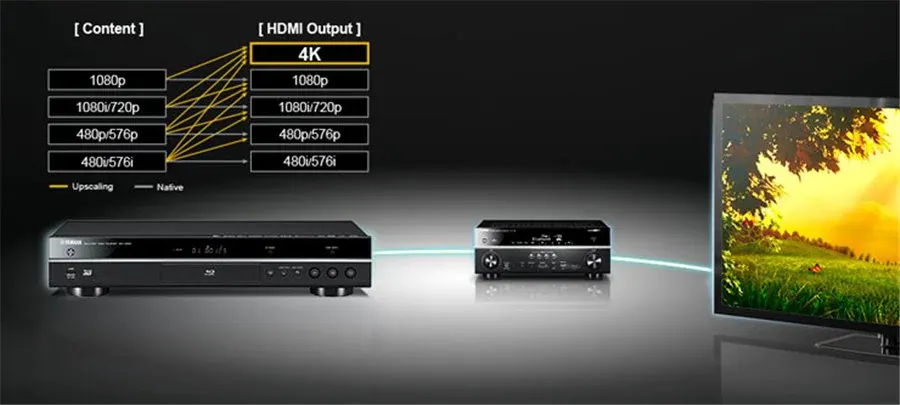The advent of high-resolution display technologies has revolutionized the way we experience content on our TVs.
A 4K Blu-ray Player produces a high 4K resolution image, whereas an upscaling 4K Blu-ray Player upgrades a normal Blu-ray disc image to a higher resolution.
One of the most significant developments in this domain has been the introduction of 4K resolution, which has four times the number of pixels as a standard 1080p display.
This technology has been embraced by TV manufacturers, content producers, and streaming services, and has led to a proliferation of 4K-compatible devices in the market.
Among these, 4K Blu-ray players are an increasingly popular choice for home theater enthusiasts.
However, there is some confusion surrounding the difference between a 4K Blu-ray player and a 4K upscaling Blu-ray player.
In this article, we will explore the distinction between the two and help you understand which one is right for you. So, without any further ado, let’s dig in!
What Is A 4K Blu-Ray Player?
Before we hop on to the differences section, what is exactly a 4K Blu-ray Player?
A 4K Blu-ray player is a device that can play back content recorded in 4K resolution on a compatible display.
These players are capable of playing standard 4K Blu-ray discs, having a capacity of up to 100GB and offer superior image and sound quality compared to regular Blu-ray discs.
4K Blu-ray players also support a variety of audio formats, including Dolby Atmos and DTS:X, which provide an immersive, three-dimensional audio experience.
One of the key features of a 4K Blu-ray player is its ability to playback HDR (High Dynamic Range) content.
HDR is a technology that expands the color and contrast range of a video signal, resulting in brighter highlights, deeper blacks, and more dynamic colors.
HDR content is typically encoded using the HDR10 or Dolby Vision standards, both of which are supported by most 4K Blu-ray players.

What Is A 4K Upscaling Blu-Ray Player?
Moving on, a 4K upscaling Blu-ray player is a device that can take standard 1080p or lower resolution content and convert it to 4K resolution for playback on a compatible display.
These players act on a process called upscaling to interpolate additional pixels from the source material, resulting in a higher-resolution image.
However, the quality of the upscaled image can vary depending on the quality of the source material and the upscaling algorithm used by the player.
4K upscaling Blu-ray players also support HDR content, but they do not have the same capabilities as a 4K Blu-ray player when it comes to playing back native 4K content.
This means that while an upscaled image may look better than a standard 1080p image, it may not be as good as a true 4K image played back on a 4K Blu-ray player.

Differences Between 4K Blu-Ray And 4K Upscaling Blu-Ray Player
In this section, we’ll be discussing the prominent differences between a 4K Blu-Ray and 4K Upscaling Blu-Ray Player.
Native 4K content playback:
The primary difference between a 4K Blu-ray player and a 4K upscaling Blu-ray player is their ability to play back native 4K content.
A 4K Blu-ray player can play back standard 4K Blu-ray discs, which offer the best possible image and sound quality, while a 4K upscaling Blu-ray player can only upscale lower resolution content to 4K.
Quality of upscaling:
While a 4K upscaling Blu-ray player can improve the quality of lower-resolution content, the quality of the upscaled image can vary depending on the quality of the source material and the upscaling algorithm used by the player.
In contrast, a 4K Blu-ray player can provide a consistent high-quality image, as the content is already recorded in 4K resolution.
Price:
4K Blu-ray players tend to be more expensive than 4K upscaling Blu-ray players due to their ability to play back native 4K content.
Storage capacity:
4K Blu-ray discs have a capacity of up to 100GB, which is significantly larger than the capacity of regular Blu-ray discs.
This allows 4K Blu-ray players to offer higher quality video and audio content than can be found on regular Blu-ray discs.
In contrast, 4K upscaling Blu-ray players rely on the quality of the source material, which may not be able to match the higher quality content found on 4K Blu-ray discs.
Audio support:
4K Blu-ray players typically support a wide range of audio formats, including Dolby Atmos and DTS:X, which provide an immersive, three-dimensional audio experience.
In contrast, 4K upscaling Blu-ray players may not have the same level of audio support, depending on the model.
| Feature | 4K Blu-ray player | 4K upscaling Blu-ray player |
|---|---|---|
| Native 4K content | Yes | No |
| Image quality | Superior | Improved from lower resolution source |
| Sound quality | Superior, support for Dolby Atmos and DTS:X | Limited depending on the model |
| Storage capacity | Up to 100GB | Same as regular Blu-ray discs |
| Audio support | Wide range of formats supported | Limited depending on the model |
| Cost | More expensive | Less expensive |
Which One Should You Choose?
If you have a 4K TV and are interested in getting the best possible image and sound quality, then a 4K Blu-ray player is the best choice.
A 4K Blu-ray player will allow you to play back native 4K content, which offers superior image and sound quality compared to upscaled content.
Additionally, 4K Blu-ray players support a wider range of audio formats, which can provide a more immersive viewing experience.
On the other hand, if you have a large collection of regular Blu-ray discs or DVDs and are not interested in investing in new 4K content, then a 4K upscaling Blu-ray player may be a more cost-effective choice.
An upscaling Blu-ray player can improve the quality of lower-resolution content and provide a better viewing experience than a standard 1080p player. Additionally, many 4K upscaling Blu-ray players also support HDR content, which can enhance the color and contrast of the image.
FAQs (Frequently Asked Questions)
What is the difference between a 4K Blu-ray player and a regular Blu-ray player?
The primary difference between a 4K Blu-Ray Player and a standard Blu-Ray Player is that a 4K Blu-Ray Player plays content at 4K resolution, while the standard version plays content at 1080 pixels resolution.
Can a 4K upscaling Blu-ray player play native 4K content?
No, a 4K upscaling Blu-ray player can only improve the quality of lower-resolution content. It cannot play back native 4K content.
Do all 4K Blu-ray players support HDR content?
No, not all 4K Blu-ray players support HDR content. HDR support may vary depending on the specific model and manufacturer.
Conclusion:
The primary difference between a 4K Blu-ray player and a 4K upscaling Blu-ray player is their ability to play back native 4K content.
While a 4K upscaling Blu-ray player can improve the quality of lower resolution content, a 4K Blu-ray player provides superior image and sound quality by playing back native 4K content.
Ultimately, the choice between the two will depend on your personal preferences and the type of content you are interested in.
If you are interested in getting the best possible image and sound quality, then a 4K Blu-ray player is the best choice, while a 4K upscaling Blu-ray player is a more cost-effective choice for those with a large collection of regular Blu-ray discs or DVDs.

